In the north of Tuscany and in the province of Lucca, the Garfagnana is a little known but pleasant region that deserves to be discovered. It stretches between the Apuan Alps and the Apennines, at the foot of peaks exceeding 2000 meters.
It remains little touristy, including the river Serchio along which you can as well hike as canoeing. Its lands are authentic, with several wild valleys, lakes and charming villages. These include Castelnuovo di Garfagnana with its fortress; the village of San Pellegrino in Alpe and its Giro del Diavolo, a panoramic hiking trail; the canyon of Orrido di Botri; the Cave of the Wind with its suspended walkway above chasms; the Hermitage of Calomini where a sacred image reappeared in a cave of the Turrite valley; the surprising Devil’s Bridge near Borgo, and many others. Its wealth combines traditions and gastronomy, including products around chestnut, spelt and cheeses.
This main valley is crossed by the river Serchio.
Tourist map with the main places
If you see this after your page is loaded completely, leafletJS files are missing.
Downstream to upstream, up the valley (from south to north):
Devil’s Bridge
Between Borgo and Mozzano is the famous Devil’s bridge, originally called Madeleine Bridge (in Italian: Ponte della Maddalena), one of the symbols of the Garfagnana, a superb medieval building from the 14th century “on donkey” with its semicircular arch and asymmetry above the Serchio river.
It is considered the gateway to the Garfagnana. Its real name is Ponte della Maddalena, because on one side was a chapel dedicated to Madeleine.
Its allure is original with its slenderness and the large round arch flanked by three smaller arches. There are uncertainties about its construction, 12th or 13th century, the three small arches being perhaps an extension to replace a part previously in wood.
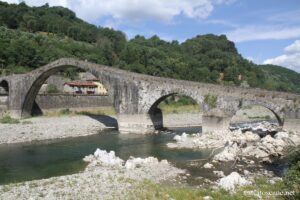
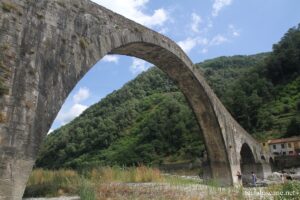
Bagni di Lucca
Along the Lima river, up to the Pistoia Mountain, Bagni di Lucca has a spa known throughout Europe and one of the most chic, thanks to its waters appreciated at least since the eleventh century when it was one of the most important in Europe, at the time of the Countess Mathilde of Canossa. There are 19 sources, some of which exceed 50°.
There are beautiful hikes around, and you can visit the Museum of the impossible in the villa Buonvisi Webb.
The station was particularly successful with the British and they designated the site as the «Switzerland of Tuscany». Many celebrities met there, such as writers, musicians, emperors, and even popes.
The Liberty complex of the Real Casino dates back to 1839, one of the first gambling houses in Europe, and here you will find an Anglican church, an English cemetery, a Circle of Foreigners, villas and parks, the Demidoff Hospital designed by the Russian prince Niccolò Demidoff, the park of Villa Fiori with 2 medieval-inspired towers. Near the bridge in Serraglio is a fountain with hot spring water.
The Bagni Bernabò has 19th century marble dressing rooms and bathtubs, a steam cave, etc.
The Chain Bridge (Ponte delle Catene in Italian) is one of the oldest standing iron bridges connecting two quarters, built in the 19th century after the destruction of an older English-inspired bridge, and rebuilt after the Second World War.
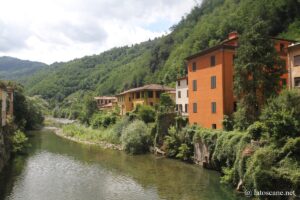
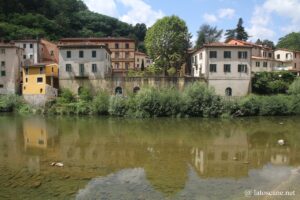
Antelminelli Coreglia
With its well-preserved historic centre, Coreglia is also a village in the middle of a green landscape in the middle of the Serchio valley, ideal for hiking, walking, horseback riding or mountain biking.
It offers a special Museum of plaster figurines, with nearly 1300 pieces.
Orrido di Botri Canyon
The Orrido di Botri is one of the most beautiful canyons in Italy, a limestone gorge near the slopes of Mount Rondinaio, carved out by the rivers Mariana and Ribellino that join to form the Rio Pelago. The gorge is narrow and deep, with vertical walls sometimes very close that in places reach 200 meters high. Water feeding pools, waterfalls and beautiful rock formations.
A guided hiking trail allows you to discover it. It is located in a nature reserve accessible from June to September when the water level is lowest, and it is a breeding site for the golden eagle.
Vergemoli
It is one of the most beautiful areas of the Garfagnana, in its western part, where you can discover the Cave of the Wind, the Mount Forato, or the Hermitage of Calomini
Hermitage of Calomini
At 4 km from Gallicano, the Hermitage of Calomini is largely carved into the rock of a deep gorge and offers a panorama over the valley.
It dates back to around the year mile and was built over the following centuries, until today with its modern appearance, having always been a place of devotion.
Wind Cave
The Wind Cave (Grotta del Vento in Italian), in the municipality of Fornovolasco, is a spectacular karst cave carved out over time by the waters of the Apuan Alps. It is characterized by stalagtites and mites, streams, alabaster formations, lakes, crystals, etc.
It is almost 4.5 kilometres long, with an elevation of nearly 120 metres and a temperature of 10.7°.
Several guided tours are offered, on three routes of varying difficulty.
Monte Forato
The Mont Forato is known for the hole in the mountain, an arch between two peaks, which can be discovered by the Boucle du Mont Forato, a route that winds its way between the mountain peaks and the woods (about 5 hours with a difference of altitude of 700 meters) from the pretty village of Fornovolasco, an old town of blacksmiths from Brescia founded in the 17th century.
Barga
The pretty village of Barga, perched on a hill in a beautiful landscape, is ranked among the most beautiful villages in Italy and also enjoys the Orange Flag of the Italian Touring Club. Although located outside the Garfagnana in the valley of the Serchio of the Apuan Alps, it is very close and deserves a detour.
Protected by its ancient walls, the historic center is charming and the village is rich in typical restaurants and shops.
At the top is the beautiful cathedral of San Cristoforo, which has a long history and many intriguing sculptures.
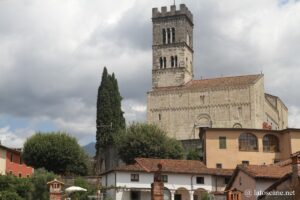
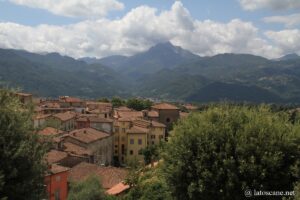
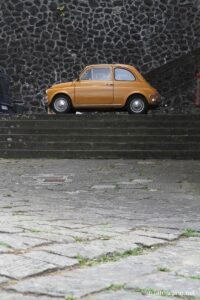
Castelnuovo di Garfagnana
Main town of the Garfagnana, Castelnuovo di Garfagnana has the main tourist facilities, less than 50 km from Lucca, with a picturesque center of colorful houses, squares, its popular markets, artisans and restaurants.
The town is controlled by the mighty fortress of the Rocca Ariostesca from the 12th-13th centuries (the east tower from the 14th century) which has recently been home to a museum. Its name is linked to the famous poet Ludovic Arioste, author of the Orlando Furioso which inspired generations of Italian puppeteers. He lived there as governor of the Garfagnana for the family of Este of Ferrara between 1522 and 1525.
On the heights outside the village, the Fortress of Mont’Alfonso is a 16th-century fortification built within the Duchy of Ferrara, near the border with the Duchy of Lucca. It has a beautiful panorama.
A few kilometres to the north, the Pontecosi Lake is a charming stretch of water with its small medieval bridge.
Isola Santa and surrounding area
The tiny village of Isola Santa is in a picturesque site of the Apuan Alps, one of the most fabulous of the Garfagnana, peaceful and medieval setting amidst the waters of a small artificial lake with turquoise colors and mirror effect.
At 3 km are the Marmitte dei Giganti, the Giant’s Pot in English, large limestone and white marble formations, accessible by a path.
From this valley you can reach the Sumbra Mountain, and the road towards the Passo del Vestito offers great views.
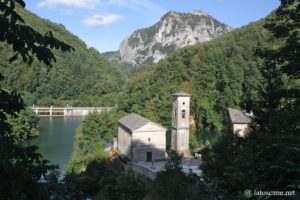
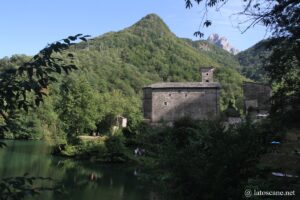
Castiglione di Garfagnana
Castiglione di Garfagnana is a small wonder, a suggestive village thanks to its remarkable medieval historic center almost intact protected by superb fortifications of the fourteenth century, and a powerful fortress remarkable whose origin goes back to the Romans. This Roman castrum was enlarged by the Lombards and then by the Franks.
It was an important fortress on the border with the Duchy of Modena.
Its two main churches, San Pietro and San Michele, date back to around the year mile.
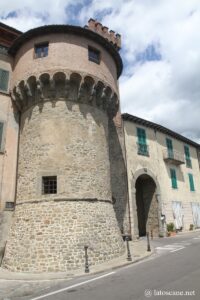
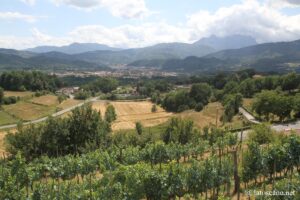
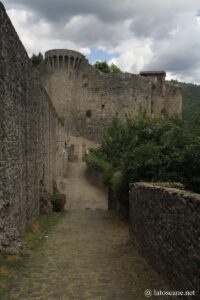
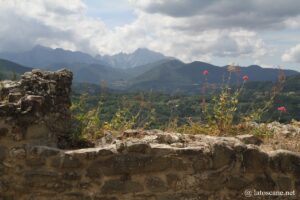
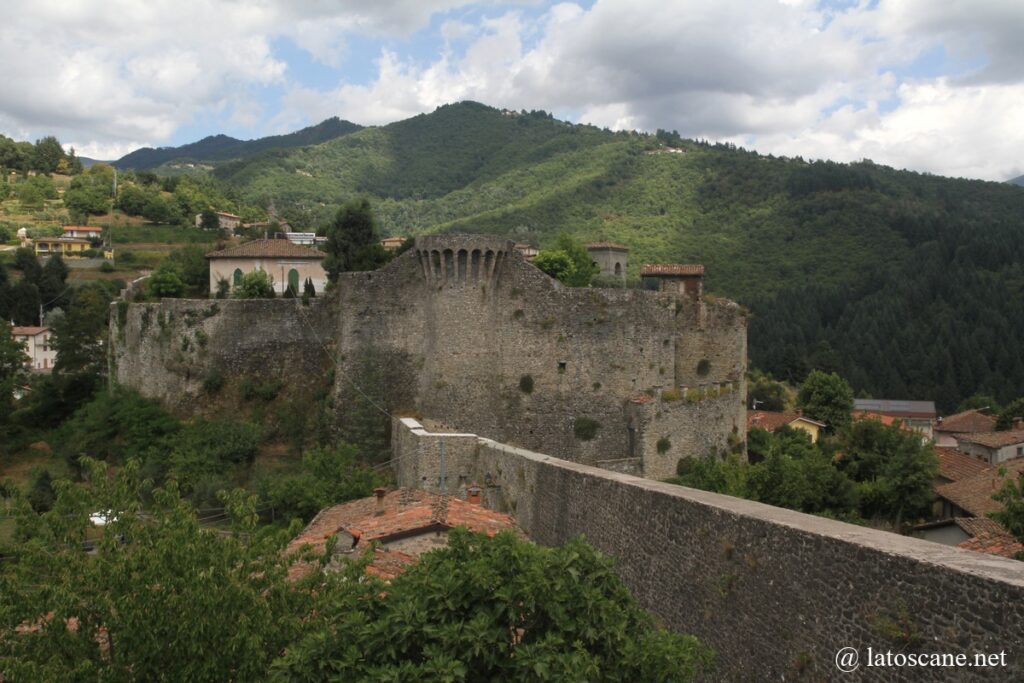
Vagli Lake and Careggine
The creation of the dam in 1947 is at the origin of the beautiful Lake of Vagli, having submerged the small village of Fabbriche di Careggine, founded in the 12th century by blacksmiths from Brescia. The inhabitants were transferred to
Vagli Sotto, a reproduction of the old village.
The lake reveals its charms along a path and dike, from the suspension bridge leading to the village, and from a Tibetan bridge with a park decorated with “polemic” statues.
Careggine is a pretty little summer resort village of ancient origin, located on the slopes of Mount Sumbra, at the foot of the Apuan Alps, with its church of Saints Peter and Paul, its giant bench (big n 55), the nearby lake.
San Romano in Garfagnana
San Romano in Garfagnana is a remarkable village for its medieval buildings, the nearby Fortezza delle Verrucole fortress and the nature reserve of Parco dell’Orecchiella
It is located in the middle of nature in the Appennino Tosco-Emiliani national park.
Its origin dates back to around the year mile when the Gherardinghi family built the fortress.
Verrucole Castle
It is one of the most interesting destinations to see in the Garfagnana. The Verrucole Castle is impressive, perched on a rocky outcrop in a strategic location to control the valley.
It was built in the 12th century and completely rebuilt in the Renaissance by the Este de Ferrara, later adapted.
In addition to its medieval charm and views of the Apuan Alps, it hosts an archeopark to immerse visitors in the Middle Ages, with characters in costumes, weapons, medicinal herbs, a siege trabouleth, etc.
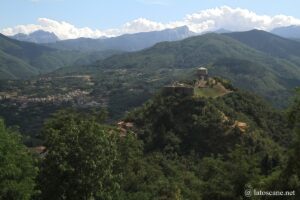
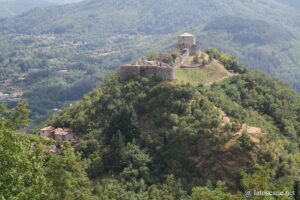
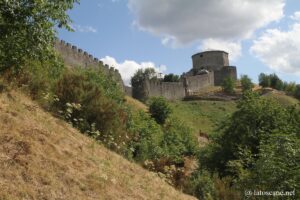
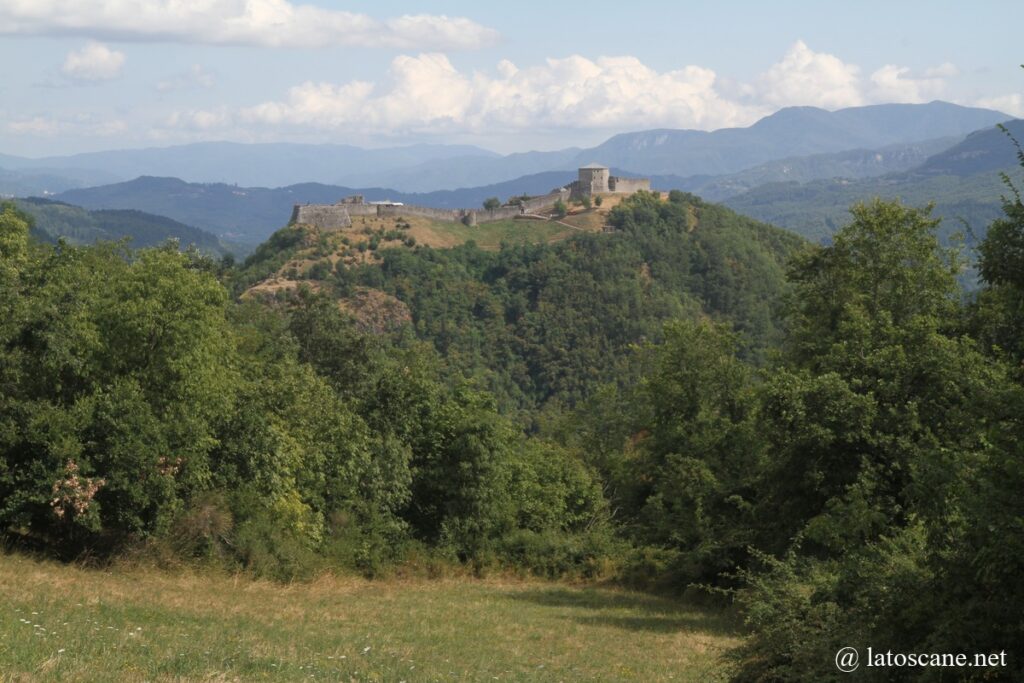
San Pellegrino in Alpe
San Pellegrino in Alpe is the highest village in the Apennines at 1525 meters above sea level, and also a mystical and fascinating site. The Ospitale of Matilde di Canossa was built to accommodate pilgrims travelling on the Via Francigena. The church preserves the remains of Saint Pellegrino, young son of the king of Scotland who lived here in poverty in communion with the animals of the forest. According to legend he fought the devil. A path joins the site called Devil’s Tour (Giro del Diavolo in Italian) offering a superb panorama from the ridge between Emilia and Tuscany.
The old hospice now houses the ethnographic museum “Don L. Pellegrini” which tells the story of the area and the structure.
Orecchiella Park
Near the village of Corfino, the Orecchiella Park is a rich nature reserve, a true paradise. The trails run through woods and habitats, where wild animals such as deer, boar, wolf, fox, various birds including the golden eagle, owls and others live. It also has a botanical garden, a bar-restaurant, a natural history museum document the local mammals and a House of Raptors.
You can see Casini, typical agricultural huts, and Lake Vicaglia.
The park also extends to Mount Pardo, the highest peak in Tuscany at 2,054 metres.
Other interesting locations in the valley
Downstream to upstream (south to north)
- Fabbriche di Vergemoli is a village of stone houses with old mills along the road, and its good restaurant Mulino Vecchio.
- Gallicano still lives on its artisans and industry, gateway to the heart of the valley.
- Molazzana has a great view from its old fortress
- Castelvecchio Pascoli is only 4 km from Barga. The name is related to Giovanni Pascoli, a famous poet whose house was here. It has been converted into a museum.
- Fosciandora is a tiny hamlet with its medieval appearance thanks to the castle, the church and a tower, the sanctuary of Migliano
- Sillico is well placed in the heights of the valley with its beautiful surrounding view. This tiny village has only a few streets, a church and an old tower, as well as a small inn.
- Pieve Fosciana is a village whose name comes from the old church of the eighth century in the middle of narrow streets with its stone houses. Near Pontecosi Lake in the valley.
- In the upper valley of the Serchio, there are various hamlets including Camporgiano with the beautiful fortress of Este, and the bucolic surroundings between rivers, lakes, forests, the nursery of La Piana, etc.
The Rocca di Camporgiano is a beautiful and ancient fortress of Renaissance origin, built by the Este family and dominating the passage of the upper valley of the Serchio, with the nearby castle of Verrucole. It houses the Civica Raccolta di Ceramiche Rinascimentali, a remarkable collection of ceramics dating from the fourteenth to sixteenth century, found in butti, the wells where waste was thrown during restorations.
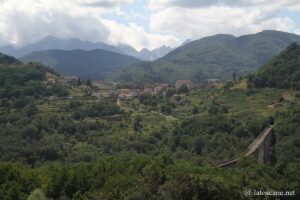
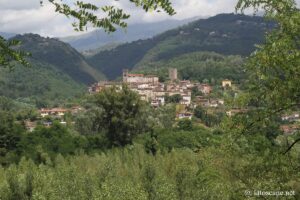
West of the valley
- Campocatino is a beautiful green valley surrounded by the Apuan Alps, trails run through the mountain one of which reaches the hermitage of San Viviano carved in the rock.
- In Gorfigliano is the High Garfagnana Identity Museum, created to preserve and enhance the history, culture and traditions of the High Garfagnana, a mountainous region rich in cultural heritage. Exhibits objects, documents, photographs and artifacts depicting past life in the area.
- In the territory of Minucciano, a wild part of the Apuan Alps, are Mount Pisanino, Lake Gramolazzo, the Caves of Equi Terme, the old church of Gorfigliano
- Gramolazzo
Near Minucciano, the lake of Gramolazzo is artificial and the largest in the Garfagnana and swimming with a beach and beautiful waters, surrounded by pine trees in a beautiful alpine setting, and navigable.
It is landscaped and has restaurants, trails, etc.
The village has an old church with its crypt and ancient marble quarries.
East of the valley
- Near Corfino is the Pania de Corfino nature reserve. The village has a medieval church of San Lorenzo Martire, rebuilt in the 18th century and incorporating Lombard elements.
In the upriver heights
- Giuncugnano is a town located at an altitude of almost 900 meters, between beautiful forests, with the Mount Argegna or the Madonna della Guardia
- At the crossroads of beautiful valleys, Sillano is close to the summit of the 2054-metre-high Mount Prado, the highest in Tuscany.
Where is the Garfagnana, map
If you see this after your page is loaded completely, leafletJS files are missing.
Activities in the Garfagnana
Links and sources
- General informations : en.wikipedia.org
- Tourist portals: www.turismo.garfagnana.eu, www.visittuscany.com


No Comments Yet